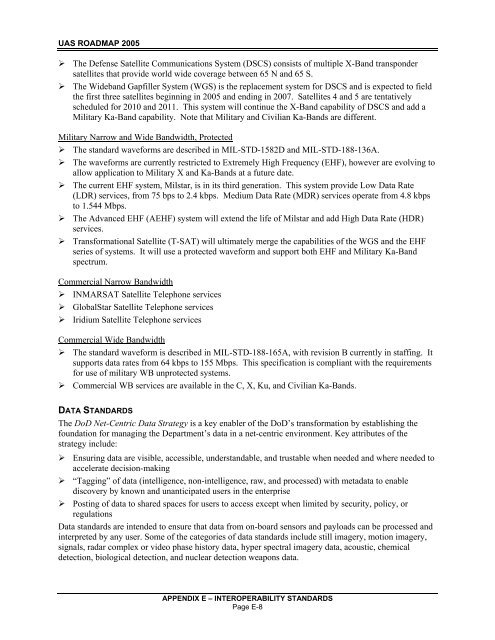Unmanned Aircraft Systems Roadmap 2005-2030 - Federation of ...
Unmanned Aircraft Systems Roadmap 2005-2030 - Federation of ...
Unmanned Aircraft Systems Roadmap 2005-2030 - Federation of ...
You also want an ePaper? Increase the reach of your titles
YUMPU automatically turns print PDFs into web optimized ePapers that Google loves.
UAS ROADMAP <strong>2005</strong><br />
� The Defense Satellite Communications System (DSCS) consists <strong>of</strong> multiple X-Band transponder<br />
satellites that provide world wide coverage between 65 N and 65 S.<br />
� The Wideband Gapfiller System (WGS) is the replacement system for DSCS and is expected to field<br />
the first three satellites beginning in <strong>2005</strong> and ending in 2007. Satellites 4 and 5 are tentatively<br />
scheduled for 2010 and 2011. This system will continue the X-Band capability <strong>of</strong> DSCS and add a<br />
Military Ka-Band capability. Note that Military and Civilian Ka-Bands are different.<br />
Military Narrow and Wide Bandwidth, Protected<br />
� The standard waveforms are described in MIL-STD-1582D and MIL-STD-188-136A.<br />
� The waveforms are currently restricted to Extremely High Frequency (EHF), however are evolving to<br />
allow application to Military X and Ka-Bands at a future date.<br />
� The current EHF system, Milstar, is in its third generation. This system provide Low Data Rate<br />
(LDR) services, from 75 bps to 2.4 kbps. Medium Data Rate (MDR) services operate from 4.8 kbps<br />
to 1.544 Mbps.<br />
� The Advanced EHF (AEHF) system will extend the life <strong>of</strong> Milstar and add High Data Rate (HDR)<br />
services.<br />
� Transformational Satellite (T-SAT) will ultimately merge the capabilities <strong>of</strong> the WGS and the EHF<br />
series <strong>of</strong> systems. It will use a protected waveform and support both EHF and Military Ka-Band<br />
spectrum.<br />
Commercial Narrow Bandwidth<br />
� INMARSAT Satellite Telephone services<br />
� GlobalStar Satellite Telephone services<br />
� Iridium Satellite Telephone services<br />
Commercial Wide Bandwidth<br />
� The standard waveform is described in MIL-STD-188-165A, with revision B currently in staffing. It<br />
supports data rates from 64 kbps to 155 Mbps. This specification is compliant with the requirements<br />
for use <strong>of</strong> military WB unprotected systems.<br />
� Commercial WB services are available in the C, X, Ku, and Civilian Ka-Bands.<br />
DATA STANDARDS<br />
The DoD Net-Centric Data Strategy is a key enabler <strong>of</strong> the DoD’s transformation by establishing the<br />
foundation for managing the Department’s data in a net-centric environment. Key attributes <strong>of</strong> the<br />
strategy include:<br />
� Ensuring data are visible, accessible, understandable, and trustable when needed and where needed to<br />
accelerate decision-making<br />
� “Tagging” <strong>of</strong> data (intelligence, non-intelligence, raw, and processed) with metadata to enable<br />
discovery by known and unanticipated users in the enterprise<br />
� Posting <strong>of</strong> data to shared spaces for users to access except when limited by security, policy, or<br />
regulations<br />
Data standards are intended to ensure that data from on-board sensors and payloads can be processed and<br />
interpreted by any user. Some <strong>of</strong> the categories <strong>of</strong> data standards include still imagery, motion imagery,<br />
signals, radar complex or video phase history data, hyper spectral imagery data, acoustic, chemical<br />
detection, biological detection, and nuclear detection weapons data.<br />
APPENDIX E – INTEROPERABILITY STANDARDS<br />
Page E-8
















